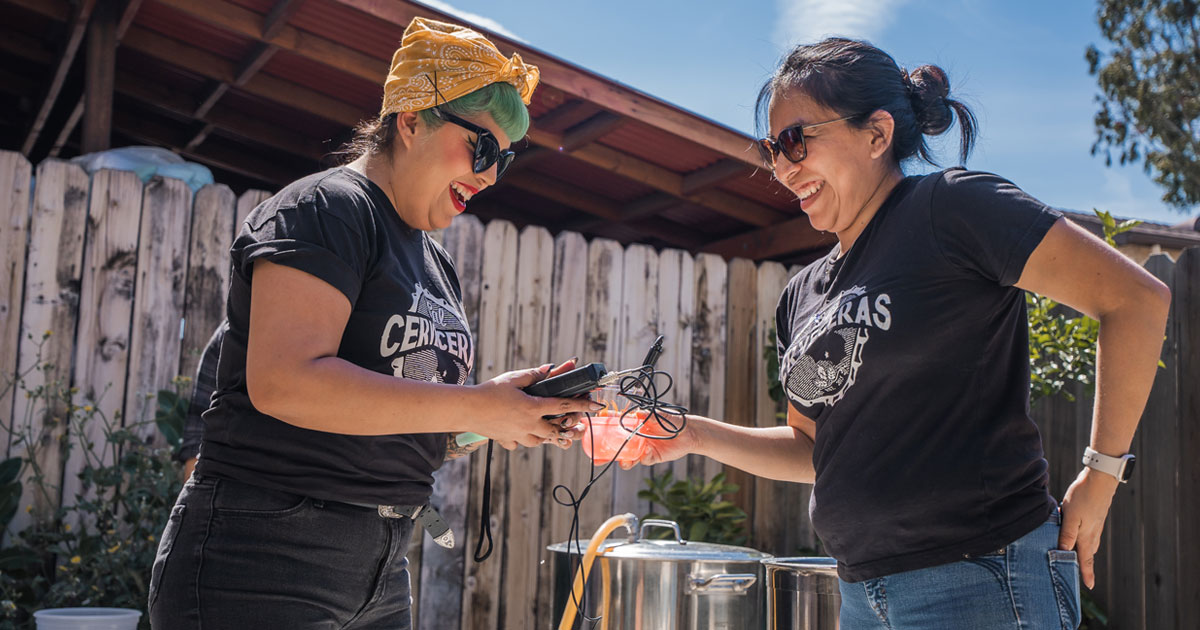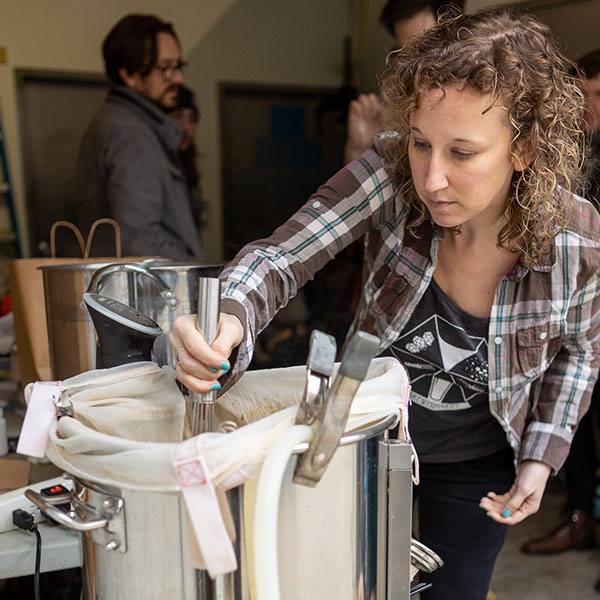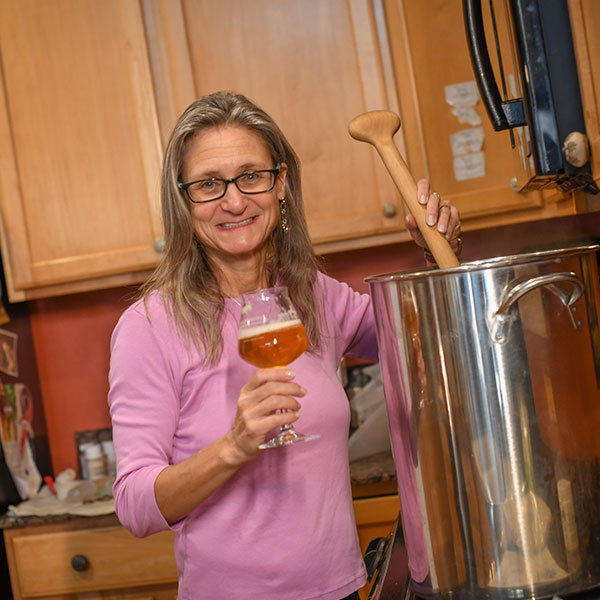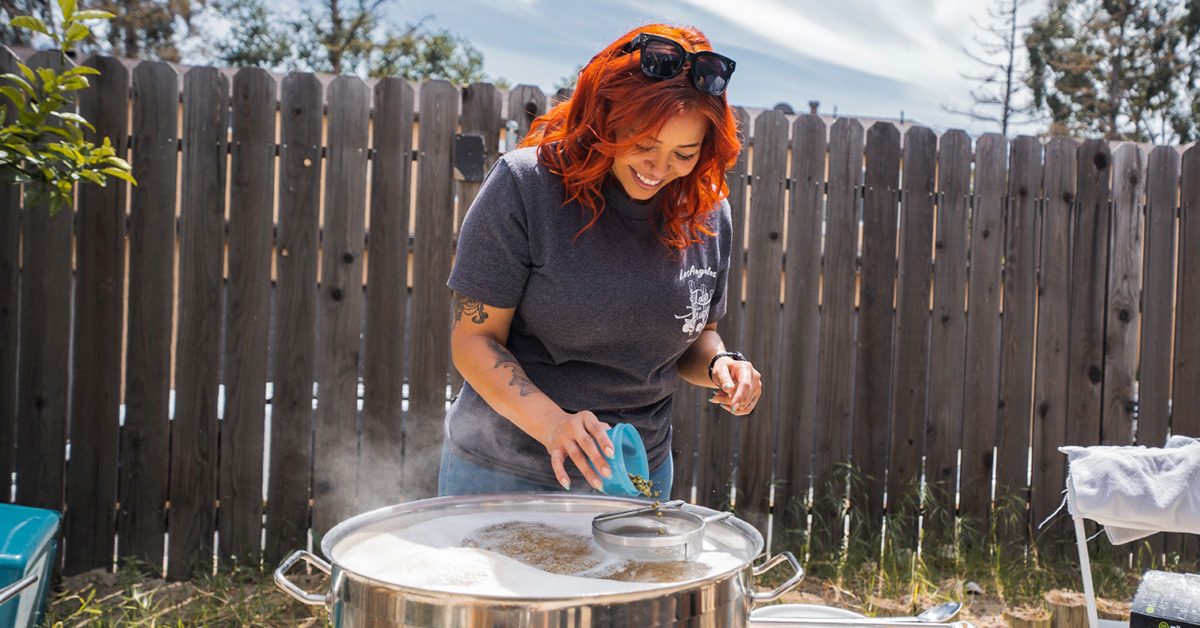There’s no skirting around the fact that homebrewing as a hobby is on the decline. Membership in the American Homebrewers Association (AHA) peaked at 46,000 in 2018 when the organization celebrated its 40th anniversary. Membership now sits at 23,000. The Beer Judge Certification Program (BJCP) has also seen a decline, with the database currently showing more inactive judges than those with active status.
Such numbers lead to an existential question for the hobby: Is homebrewing dying? And while Julia Herz, executive director of the AHA, points out that there are peaks and valleys in any organization, the steady decline in membership and participation leads many to wonder how the homebrewing hobby can be saved.
The answer might be to get more women involved. While women are currently a minority in the homebrewing community, they are increasingly taking on leadership roles and becoming the most outspoken proponents of the hobby. So how can the community get more women to join? By breaking down barriers and encouraging more women to brew their first batch, join clubs, and get certified in programs such as the BJCP.
Why Is Homebrewing on the Decline?
There is no single answer to why interest in homebrewing—or at least membership in homebrew organizations—has fallen. However, there are many potential factors influencing the receding interest in the hobby.
Herz says one of the biggest underlying causes for waning interest in brewing is that there’s more world-class craft beer available than ever before. As of 2023, there were close to 10,000 craft breweries open across the U.S., along with imported beer from many other countries. With so much craft beer available, she speculates that homebrewers are losing interest in making their own.

Another possible cause might be the aftereffects of COVID-19. During the pandemic, many people took up the hobby as they were stuck at home and unable to get their favorite brews. As the world reopened, many of these new brewers lost interest or no longer had time to devote to brewing a batch.
Sandy Cockerham, president of the BJCP, the organization that sanctions and certifies judges for beer competitions, believes lower rates of alcohol consumption among young people could be a reason for the decline.
“We are seeing shifts in people’s drinking habits, and I’m sure that affects our judges as well,” she says.
Less interest in homebrew competition judging can have a ripple effect that impacts the hobby as a whole. Homebrewing competitions can generate excitement and drive club engagement, but without enough judges, these competitions can’t take place.
Other factors that may have influenced the drop in homebrewing interest include the closure of local homebrew shops, the impact of inflation on the cost of brewing ingredients and equipment, and an increase in homebrewers aging out or retiring from the hobby.
How Many Women Are Homebrewing?
Women have been brewing since the inception of beer. Yet somewhere between the 1600s and 1700s, brewing transformed from being a woman’s task to an industry of men. Fewer and fewer women took on the mantle of brewing as they were priced out and pushed out. New laws and the rise of commercial brewing had a compounding effect: Women didn’t have the financial independence to open their own breweries, and purity laws made individual ingredients more expensive.
The number of female brewers has only now started to increase. According to the Brewers Association (BA), women account for 23.7 percent of brewery owners. Less than 3 percent of breweries are owned solely by women.
The answer to how many women are currently homebrewingis harder to answer. When asked about female involvement in judging, Cockerham pointed out that the BJCP does not collect data on gender, nor does the AHA. This makes it impossible to know precisely how many women are involved in either organization as judges or members.
A recent survey conducted by Brulosophy, a popular homebrewing website and podcast, showed that only 2 percent of respondents identified as female, but those results might be skewed. The survey authors pointed out that 1,000 fewer people answered the survey compared to the previous year. When asked how many female homebrewers are actually out there in comparison to Brulosophy’s numbers, Herz said her gut feeling is that the number is higher than 2 percent, but likely not by very much.

Even though the numbers seem heavily male-skewed, many women in the homebrewing community are becoming the hobby’s most vocal proponents. Herz has been the AHA’s executive director for three years, and Cockerham took on the role of president at the BJCP in 2023 when the previous president stepped down.
Both of these women are not only big proponents of homebrewing as a hobby, they are also strong voices that prove women very much have a place in the future of homebrewing.
Getting More Women Involved in Homebrewing
Despite the seemingly low number of women in homebrewing, they are a fast-growing segment of beer lovers. Close to one-third of craft beer drinkers are female, according to the BA. Could that translate to more women interested in homebrewing? If so, what can existing homebrewers do to encourage women to brew that first batch?
Every brewer has that single moment or series of influences that put them on the path toward brewing their own beer.
“You can make beer? I didn’t think that was something a normal person could do,” says Sam Dolese, a Texas homebrewer who first learned about the hobby when a local group visited her college. Now, as a homebrewer with more than a decade of experience, she tries to encourage others to get involved. Outreach can be a great way to grow interest in the hobby. Seeing women involved in homebrewing can inspire others to join.
“I try to encourage all [the] women I know that are interested [in homebrewing] to participate,” says Laurie Nicholson, a member of the East Texas Brewers Guild’s homebrewing club.
For others, the inspiration to brew beer came from family. Cockerham started brewing in her late 20s after hearing her dad talk about making beer with his brother.
Herz is in a similar boat. After growing up seeing her parents drink a variety of beer styles and being intrigued by her brother’s beer can collection, she went on to brew her own beer. “In the back of my mind, I was like, yeah, I’d love to make it.”
Regardless of how they got their start, all of the women I spoke with echoed the same sentiments about why they love brewing their own beer. Experimentation was frequently mentioned, as was community. “It makes me so happy to see folks enjoy something I came up with,” says Nicholson.
The Importance of Homebrew Clubs
There’s no doubt that brew clubs are an essential part of engagement in the homebrewing community. “There are tens of thousands of people in homebrew clubs,” says Herz, whose organization publishes a directory of more than 1,900 AHA-registered brew clubs. She encourages women and everyone else interested in homebrewing to join a local club.

Joining a local club as well as the AHA greatly impacted Cockerham when she first started brewing.
“I made friends and found a chosen family,” she says. “Becoming a member of the American Homebrewers Association was [also] huge for me. I devoured the early issues of Zymurgy [magazine] and wore out a copy of The Complete Joy of Homebrewing.”
While joining a club can be a great way to gain community and encourage homebrewing activity, women often find it intimidating. “Traditionally, there have been fewer women versus men,” says Dolese of the female participation in the Nac Brew Club, a homebrewing club in Nacogdoches, Texas.
“I feel like women don’t get respect for our knowledge right off the bat like men do,” believes Nicholson. “We have to work harder to convince other male members that women are just as knowledgeable and love beer just as much.”
Building a Beer Resume
Herz talks a lot about the idea of building a beer resume and how it can help women combat intimidation and bias in the homebrewing community, especially for those pursuing a leadership role. As she says, a beer resume is much like a professional resume except that it details your brewing knowledge (e.g., batches brewed, certifications achieved, accolades).

She particularly focuses on the certification side of things, saying that the achievements can help women prove themselves and increase their confidence.
When talking about women who may not know where to start with certification, Cockerham says, “I would encourage them to try studying on their own and to steward at a competition to see what it’s all about. Don’t be afraid to ask questions!”
Cockerham has recently seen encouraging growth when it comes to women being certified as BJCP judges.
“In the U.S., personally, I have seen modest gains. In Latin America, female judges continue to grow at a good clip. Last spring, I was honored to proctor a beer exam in Ensenada [Mexico], where all 12 new examinees were women. That was a neat experience,” she says.
While women shouldn’t have to jump through extra hoops just to get the same recognition as male homebrewers, certifications and homebrew competition wins can offer validation as well as a confidence boost.
Growing Interest in the Homebrewing Hobby with the Help of Women
“Beer has no gender as a beverage,” says Herz.
The homebrewing hobby is in decline, but women could help save it. While many women currently involved are starting to see more female involvement in clubs and competition judging, they all agree there is still a long way to go.
Herz offered insight on how local clubs can grow membership and be more inclusive. She encourages them to welcome new members from all walks of life and advocates for existing brewers to help out those new to homebrewing.
This idea of helping one another out is something Dolese of the Nac Brew Club got to experience firsthand. She tells a story of how a fellow homebrewer helped her get started by generously loaning her all the equipment she needed to brew her first few batches. Her homebrew club still routinely encourages new brewers by running an annual program to pair a newbie with an experienced brewer to brew a batch together.
But it doesn’t end with offering a help hand; club attitude matters just as much. Cockerham offers her own warning to homebrew clubs looking to attract new members: “Avoid cliquish behavior,” she says, and “just be open-minded and welcoming.”
Homebrewing may be in decline, but the hobby is not going away anytime soon. And while women appear to be moving toward a bright future in the hobby, true acceptance in a male-dominated world won’t come overnight.
“In our lifetime, women-identified individuals will experience bias…[and] it’s going to take generations to shed, if ever,” Herz says.
CraftBeer.com is fully dedicated to small and independent U.S. breweries. We are published by the Brewers Association, the not-for-profit trade group dedicated to promoting and protecting America’s small and independent craft brewers. Stories and opinions shared on CraftBeer.com do not imply endorsement by or positions taken by the Brewers Association or its members.


Share Post